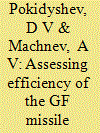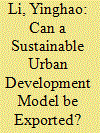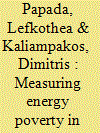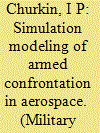|
|
|
Sort Order |
|
|
|
Items / Page
|
|
|
|
|
|
|
| Srl | Item |
| 1 |
ID:
170952


|
|
|
|
|
| Summary/Abstract |
The authors present the hierarchy analysis method as a means of assessing the efficiency of the Ground Forces (GF) Missile Forces control subsystem
|
|
|
|
|
|
|
|
|
|
|
|
|
|
|
|
| 2 |
ID:
162091


|
|
|
|
|
| Summary/Abstract |
In the search for more sustainable models for Chinese cities, the concept of “eco-city” has been advanced and widely discussed as capable of providing solutions for environmental, ecological, and socio-economic problems. This article questions the specificities of the concept against lessons drawn from the experiences of eco- and sustainable quarters being implemented in France and other places in Europe. The model for a Chinese eco-city is considered in the light of our study of the Tianjin eco-city, which is a Sino-Singaporean project half-way towards its intended completion in 2020. Our study was conducted on the spot within this eco-city, and it enables us to make a close examination of a number of its specific aspects and to raise questions, in a manner not yet fully researched in this area, as to how widely such an urban model might be diffused. Its implementation of a system of performance indicators, and its introduction of a structure of governance to support environmental protection, represent promising avenues for a paradigm change in Chinese urban planning. On the other hand, the bias in favour of technological solutions and the lack of concern with the residents’ life styles are a matter for debate over the pertinence and sustainability of such a model for urban development.
|
|
|
|
|
|
|
|
|
|
|
|
|
|
|
|
| 3 |
ID:
150657


|
|
|
|
|
| Summary/Abstract |
A comprehensive research in the field of energy poverty is undertaken in this paper, in an attempt to highlight the great vulnerability of Greek households on energy poverty, in the middle of a severe economic crisis. Till now, Greek energy policy has been considered insufficient to tackle energy poverty issues, as focusing mainly on short-term rather than permanent solutions. A primary survey has been conducted, recording objective data of energy expenses as well as subjective perceptions about housing conditions. The findings showed that, under the objective expenditure-based method, 58% of Greek households are energy poor. Among households under the poverty threshold, the energy poverty rate exceeds 90%. Existing and new subjective indicators shed light on other aspects of energy poverty, such as the level of thermal comfort at home, damp problems detected, restriction of other essential needs in order to manage energy payments, etc. Some interesting conclusions are also drawn by exploring the relationship between various indicators. It appears that households considered energy poor are not identical when examined by objective and subjective indicators. However, different indicators complement each other by capturing different aspects of the problem and provide a broader overview of the issue.
|
|
|
|
|
|
|
|
|
|
|
|
|
|
|
|
| 4 |
ID:
162564


|
|
|
|
|
| Summary/Abstract |
This paper examines the scope of the simulation modeling method to propose the general theoretical aspects and grounds of creating and applying simulation modeling of armed confrontation by troop/force groupings in aerospace.
|
|
|
|
|
|
|
|
|
|
|
|
|
|
|
|
| 5 |
ID:
110416


|
|
|
|
|
| Publication |
2011.
|
| Summary/Abstract |
This study develops and examines physical energy intensity indicators in five industrial sub-sectors-iron and steel, aluminum, textiles, paper, and cement-and investigates mitigation options for energy related CO2 emissions (during 1991-2005). Decomposition analysis has been employed to separate the structural effect (share of different products in the sector) from pure intensity effect (efficiency increase through technical improvement) for each industry. The results show that the combined effect (considering both structural and intensity effects together) on both iron and steel and paper and pulp industries is negative while it is positive for aluminum and textiles. The intensity effect for all the industries, barring textiles, is negative showing improvement in energy efficiency; iron and steel in particular, has seen a decrease of 134 PJ in energy consumption owing to improvements in efficiency. However, energy intensity in textiles has risen by 47 PJ due to increased mechanization. Structural effect is positive in aluminum and iron and steel industries indicating a movement towards higher energy-intensive products. In the case of aluminum, positive structural effect dominates over negative intensive effect whereas negative intensive effect dominates iron and steel industry. The paper helps in designing policies for improving productivity and reduce energy consumption in India's manufacturing sector.
|
|
|
|
|
|
|
|
|
|
|
|
|
|
|
|
|
|
|
|
|